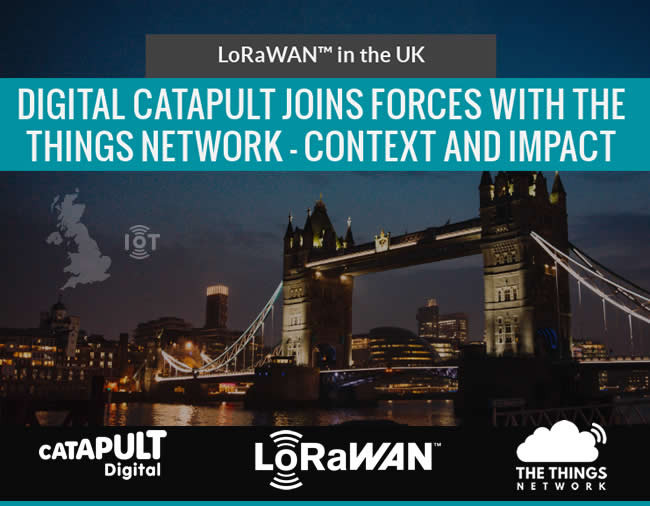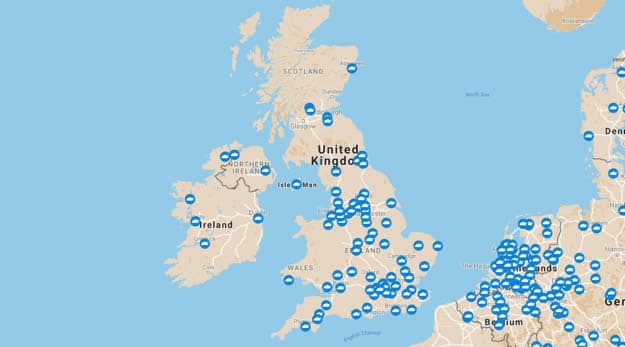Low power wide area wireless IoT network standard LoRaWAN is about to get a boost in the UK. The collaboration between Digital Catapult and The Things Network (TTN), announced on June 18, 2018, has everything to do with it.
Why a boost, a term we like to use with care? Not (just) because of the traditional expanded coverage message. The true power sits in the no-nonsense, practice-oriented and ecosystem-by-design community approach of both Internet of Things parties.
While analysts forecast that the number of 3GPP cellular LPWA IoT connections globally will be larger than the number of non-cellular LPWA network connections by 2023 (mainly LoRaWAN and Sigfox) there certainly remains a place for non-cellular players.
As mentioned several times before each IoT use case, project and type of user/customer/industry comes with its specific needs whereby the best (mix) of IoT communications options and ecosystems can hugely differ. Another factor to keep in mind is the geographically different picture we keep hammering on. And then there is the fact that no one in the LPWA network space of course is exactly sitting still.
LoRaWAN (with the LoRa Alliance ecosystem) has been on the rise in the UK for several years now and the collaboration between Digital Catapult and The Things Network opens the door for new opportunities. Here is why and how.

Digital Catapult and The Things Network: how part one of the equation evolved
We’ve covered the launch of the ‘Things Connected’ initiative by UK digital technology innovation center Digital Catapult, BT, Everynet, Beecham Research and some leading universities when it was announced in 2016.
The aim of Things Connected was to have a free of charge open IoT testbed, initially covering London with LoRaWAN.
That open IoT testbed, which Things Connected essentially is, since then has broadened. The primary goal remains the support of small UK businesses, including start-ups, using LPWAN technologies through experimentation and prototyping (now LoRaWAN and Sigfox).
Today Things Connected has 145 LPWAN base stations, covering 6 regions in the UK, including London. The focus remains a community-based one to get IoT solutions to market faster.

Among the supporting partners is AllThingsTalk, a Belgian start-up with international ambitions we mentioned previously: AllThingsTalk delivers the Orange NB-IoT Rapid Development kit and IoT platform of the Orange Belgium NB-IoT offering. It does the same for the LoRaWAN offering of Proximus and within the Things Connected program (AllThingsTalk has a platform integration with both Digital Catapult and The Things Network). Other partners include IoT smart products platform provider EVRYTHNG and WND UK, the latter two Sigfox ecosystem partners.
Peter Karney, Head of Product Innovation at Digital Catapult believes that LPWAN connectivity will be the driving force behind the uptake of IoT, bringing new companies and services to market
The Things Network – a natural ally for Digital Catapult
In the meantime, The Things Network has also been growing its LPWAN footprint in the UK. The Things Network has an entirely different background though.
Born out of the brain of its Dutch founder Wienke Giezeman, who discovered LoRa and LoRaWAN and started The Things Network as a crowd-sourced and crowd-funded initiative in 2015, The Things Network is an interesting story on its own.
The goal of The Things Network was to build a free and open LoRaWAN network whereby the city of Amsterdam would be “connected first” and serve as a test case of Wienke’s vision. The crowdsourced aspect was in developing a LoRaWAN IoT gateway that citizens could install themselves.
Part of the money to do so was raised via Kickstarter. With several of Amsterdam’s innovation-oriented actors (the Port of Amsterdam, the city of Amsterdam, De Waag Society and start-up oriented innovation divisions of companies such as KPMG and Deloitte, to name a few) and the strong Dutch start-up community playing a key role, among others with regards to visibility (e.g. Boris Veldhuijzen van Zanten, among others known from The Next Web), Amsterdam-wide coverage was quickly achieved.

Success was the result and further development beyond Amsterdam, let alone The Netherlands, the plan. So, The Things Network continued its journey of building an IoT network, based upon LoRaWAN and with the same community approach, underlying philosophy, open source code and focus on getting business, ‘makers’, startups and so forth testing the waters of IoT, getting connected fast and able to shorten the time to market.
All this is, among others, achieved through the community as such, sharing experiences regarding projects, a bunch of learning material, the forum, the code and a marketplace offering some pre-built solutions, devices and services from partners (of which some are Dutch as well, the IoT innovation scene in The Netherlands and neighboring countries Belgium and Germany is pretty impressive). There are also several integrations, among others with Azure IoT.
The combined power of Digital Catapult’s Things Connected and The Things Network
As The Things Network project expanded (with activities in places across various countries such as the Brazil, the US, Australia, India, Belgium, Canada, Singapore, Japan and South-Africa to cite a few and always with initiators launching regional communities), also in the UK there was quite some activity.
LoRaWAN coverage through The Things Network communities grew. The Things Network today has 63 UK communities with over 700 members and 300 base stations. Add those LoRaWAN base stations to the 145 of Things Connected (Digital Catapult) and you have one of several reasons why The Things Network and Digital Catapult’s Things Connected announced they join forces as of June 2018.
Coverage of the network, as compared to some other initiatives and players (think Sigfox, for example) isn’t the only, let alone key, focus in the announcement on the collaboration though and shows how The Things Network and Things Connected stick to their enabling and empowering approach of communities and collaborations.
Even if expanding LoRaWAN coverage in the UK obviously matters as is reflected in the title of the announcement, “Digital Catapult joins forces with The Things Network expanding UK LoRaWAN coverage“, the subtitle focuses on how the partnership between Digital Catapult and The Things Network aims to create the UK’s largest LoRaWAN network and innovation community.
Two free LoRaWAN networks, a bunch of organizations and people in the respective communities of start-ups, makers, businesses, individuals, testers and a focus on innovative solutions within the broad range of IoT use cases and solutions where LoRaWAN fits is precisely what the strength of this collaboration is about.
When people, communities, innovation and true value opportunities meet
Exchanging ideas and support to move from visions, prototypes and pilots to actual IoT deployments or new services/solutions and an ecosystem-by-design approach, along with easy ways to realize business with IoT and support of communities (let’s not forget the role of the LoRa Alliance in which all actors are present here as well), combined with innovative mindsets and a no-nonsense approach: it’s always a winning combination.
Why? Because the power still is and remains about people and communities realizing value and innovative services for real challenges and enhancements with IoT as that vast umbrella term for enabling technologies in the broader scope.
Will this approach work for everyone? For sure not. But that’s normal: LoRaWAN nor LPWAN fit in all use cases and goals of organizations. Ecosystems of large players meet often entirely different needs in the ‘more advanced applications’ so to speak (think the use cases, types of goals and typical technologies leveraged by those few top leading manufacturers globally for example in what has been called Industry 4.0).
Yet the plain and simple truth is that, although with IoT in manufacturing we are where the big money sits from a global IoT spending perspective, in the end for most it is still early days in IoT, believe it or not, and there is a very large group of organizations, including larger ones, involved in initiatives such as those from Digital Catapult and The Things Network.
This includes use cases and markets where there is more money and LPWAN does play a role with smart buildings and facility optimization overall being one. Let’s also not forget that LPWAN, as confirmed by the mentioned research, is particularly present in smart meters and facility tracking applications in all sorts of forms.
Last but not least, there is the smart cities ‘market’ and shipping. Cities might not be the big spenders in IoT but they certainly deploy projects that bring benefits for citizens on a pretty massive scale. And the budget issue is clearly driving the choice for particular technologies and providers.
There is a reason why in smart city platform selections open source is a priority for many and certainly why LPWAN (also given the technical needs of use cases) and open ecosystems such as the one enhanced by the collaboration between Digital Catapult and The Things Network is important in this smart city IoT application space.

All pictures and logos belong to their respective owners.

